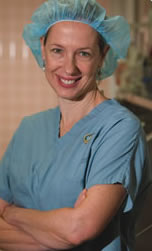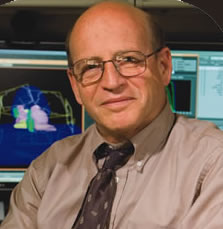Form and Function
Curing Head and Neck Cancer is Only Part of the Challenge

Not long ago, Lisa Bourdon-Krause walked into a restaurant. She ordered a hamburger and a coke. She ate the hamburger. She Sipped the coke through a straw. On the way home, she entertained her two young children with silly songs. Ordinary stuff, you say? Not to Bourdon-Krause. The simple acts of chewing, swallowing, sipping, and especially communicating With her family became extraordinarily important when, diagnosed with oral cancer and facing surgery to remove half her tongue, she thought she might lose all of those abilities.
She didn't, and her seemingly commonplace visit to the hamburger joint is a testament to her successful treatment by a University of Michigan Rogel Cancer Center team that cared not only about curing the young mother's cancer, but also about returning her to something close to her pre-cancer life. Leading a quality life after cancer treatment is always a concern, but with head and neck cancers -- those that originate in the mouth, nose and throat -- patients' apprehensions are especially acute.
"So much of who we are as people involves our head and neck region," says Carol Bradford, M.d., co-director of the cancer center's Head and Neck Oncology Program. "Talking, tasting, interacting with other people and the world around us are all so important to our sense of identity."
Traditionally, many treatments for head and neck cancers have been devastating to self-image and dignity: surgeries that leave patients disfigured or unable to speak clearly, radiation treatments that wither salivary glands and make eating and swallowing difficult. But new approaches, many pioneered at U-M, focus on preserving appearance, function and sense of self, without compromising a patient's chances for a cure.
It's a mission that requires a coordinated, patient-centered effort from a team of specialists: surgical oncologists with expertise in head and neck and reconstructive surgery, medical oncologists, radiologists, radiation oncologists, nurses, dietitians, speech pathologists, physical therapists, schedulers, physician assistants, medical assistants, dentists, prosthodontists and social workers. And it's a mission that's becoming increasingly important.
Squamous origins

Lining the moist, inner surfaces of the mouth, nose and throat is a mosaic of flat, scale-like cells called squamous cells. It's here that most head and neck cancers originate, often spurred by tobacco use and heavy drinking, but sometimes -- recent research suggests -- by stealthy viruses. If not detected and treated early, these malignancies can quickly spread to lymph nodes in the neck and on to the lungs and other parts of the body.
At one time, the typical head and neck cancer patient was a 60-year-old man with a smoker's rasp and a liking for liquor, but nowadays doctors are seeing more and more young, clean-living patients, many with cancers that test positive for the presence of human papilloma virus (HPV, the same virus that causes cervical cancer), and some with cancers whose cause is unknown. "We're in the midst of an HPV epidemic," bradford says. "Seventy-five% or more of the patients we see with tonsil, throat and base-of-tongue cancer have hpv-related cancer." This preponderance of youthful, active, otherwise healthy patients has contributed to the push for approaches that allow for normal, productive lives after treatment.
Bourdon-Krause was only 30, married not quite six years, working full time and the mother of a toddler, when she started feeling twinges along the left side of her tongue whenever she chewed gum or drank through a straw.
"At first it was just a mild pain, and I didn't pay much attention to it," she says. But after a month or so of putting up with the discomfort, she got curious and took a look in the mirror. "There was a sunken spot that was white and pitted. I looked at it and went, "Oh, my Lord!' but I didn't freak out. I had no clue there was such a thing as tongue cancer."
She mentioned the spot during a dental exam; the dentist sent her to an oral surgeon, who took a biopsy. When the results came back positive for carcinoma of the tongue, Bourdon- Krause was referred to an ear, nose and throat specialist in her hometown of Bay City, who examined her and ordered a few more tests, then sent her to the U-M for treatment.
"There was an element of confidence -- a 'We can do this' attitude," she says of her treatment team. "That made me feel better." Because tongue cancers don't respond well to chemotherapy and radiation, Bourdon-Krause's team recommended surgery: removing half her tongue and all the lymph nodes in her neck on the side where the cancer was found. The tongue, basically a single slab of muscle, has no barriers to prevent cancer from spreading from the spot where it starts, "so you want to make sure you get an adequate margin around the tumor to ensure that it doesn't ever come back," says Bradford, who performed Bourdon-Krause's surgery.
At one time, removing half of her tongue would have meant that Bourdon-Krause wouldn't be able to consume a normal diet, particularly in public, and her speech would be forever slurred, with a "sloppy, two-or-threebeers-onboard" quality, says Douglas Chepeha, M.D., who reconstructed Bourdon-Krause's tongue after Bradford removed the tumor and surrounding tissue. But thanks to Chepeha's skills -- and his willingness to go to great lengths to make sure the tongues, jaws and cheeks he rebuilds function as much like the originals as possible -- Bourdon-Krause could lose half her tongue and still look forward to teaching her son the alphabet and taking him out for burgers."
Reconstructing Function by Micro Repair
On the table before him, Chepeha spreads out a small square of paper on which he has drawn a pattern of numbered, interlocking pieces, something like the design for a child's first jigsaw puzzle. It's the pattern for Bourdon-Krause's tongue graft. Through his own research and consultation with speech pathologists, Chepeha has come up with benchmarks that reconstructed tongues must meet, so that patients can function in public with respect to eating and speaking. For example, a tongue needs to touch the back of the teeth to make certain consonant sounds, and it should be able to stick out 5 millimeters to 7 millimeters beyond the teeth in order to lick crumbs from the lips.
To reconstruct Bourdon-Krause's tongue during the 11-hour surgery, Chepeha designed a patch of skin and underlying fat from her forearm for transplantation. He folded it like origami and painstakingly connected tiny blood vessels in the transplant to vessels in what was left of Bourdon-Krause's own tongue.

The night before her surgery, fearful that the reconstruction might not be successful and she'd never be able to speak to her 2-year-old son, Logan, Bourdon-Krause had stayed up late recording messages for the child.
"I started thinking, if I couldn't talk ever again, what would I want to say to him?" she recalls. "Some of it was basic mom-of-a-toddler things like, 'come here, let me change your diaper.' But part of it was a lasting keepsake I wanted to create: 'how was your day?' 'i love you.' " After several tearful tries, she also recorded herself reading some of her son's favorite storybooks.
It was a loving gesture, but one that, happily, turned out to be unnecessary. Within a week after surgery, Bourdon-Krause was talking, and with continued speech therapy her enunciation improved. She was back at her job as a graphic designer, participating in meetings and making phone calls to print vendors six weeks after her surgery.
"I don't sound exactly the same as I did," she says, "but to somebody who didn't know me before, I sound perfectly normal."
And those recorded messages and stories? Bourdon-Krause, now 39, with a second child, has burned them onto a cd for posterity.
Non-Surgical Options and Tumor Genetics
Communication was important to Chuck Coté, too. An author and motivational speaker who travels around the country making public appearances to audiences of as many as 2,000 people, Coté thought he'd surely lose his livelihood -- if not his life -- when he was diagnosed with tonsil cancer that had spread to his throat and palate. The doctor who made the initial diagnosis proposed radical surgery that would take part of Coté's jaw and throat and leave him not only disfigured but also unable to speak clearly.

Fortunately, Coté sought a second opinion at U-M, where he learned that for certain cancers, non-surgical treatments are possible. In fact, such approaches have been a major focus of the U-M Head and Neck Oncology Program since 2001, when the program was awarded one of the National Cancer Institute's first Specialized Programs of Research Excellence grants. Spore awards are intended to promote interdisciplinary research and move basic research findings from the laboratory to clinical settings. The expressed goal of the Michigan program was to further the development of organ-preserving treatments, and to personalize them to the individual patient, says gregory Wolf, M.d., professor of otolaryngology.
The first success for this approach was with laryngeal cancer patients, for whom the usual treatment was removal of the voice box. "By combining chemotherapy and radiation, we proved that there were alternatives to total laryngectomy and that cure rates were excellent," Wolf says. But Wolf and coworkers wanted to do a better job of matching treatment regimens to patient needs, and to extend these findings to patients with other types of mouth and throat cancer.
"We wanted to see if we could predict, based on the genes present in a patient's tumor, which patients would respond best to chemotherapy and radiation and which would really need to have surgery," Wolf says. Indeed, tumor genetics, along with patients' responses to chemotherapy test doses, did reveal which patients would do best with which treatment. When patients were screened in this way, some 70% were able to have their voice boxes preserved, and both groups -- those that qualified for voice box-preserving chemotherapy and radiation and those that needed laryngectomy -- did exceptionally well.
"For example, in advanced stage III and stage IV laryngeal cancer, where the traditional cure rate for five years is in the 60 to 70% range, our cure rates are in the high 80 to 90% range," Wolf says. bolstered by that success, the group went on to investigate use of the screening method for patients with other head and neck cancers, including tonsil.
That's how Coté, whose apple-sized tumor already was making breathing and swallowing difficult, was able to avoid mutilating surgery. Enrolled in a clinical trial, Coté responded well enough to a test dose of chemotherapy to be treated with radiation and chemotherapy alone.
Though not as extreme as surgery, these less radical treatments can still have debilitating effects. In particular, radiation to the head and neck can destroy salivary glands and damage muscles involved in swallowing. But advanced radiation techniques pioneered at Michigan 15 years ago precisely target tumors and tissues where the cancer may have spread while sparing normal tissue, says Avraham Eisbruch, M.D., professor of radiation oncology.
"With the combination of radiation and chemotherapy, we now cure the large majority of patients," says Eisbruch, who was Coté's radiation oncologist. "And now that we're curing more patients, the emphasis on reducing long-term complications and side effects and improving long-term quality of life becomes even more important."
Reprinted courtesy of Medicine at Michigan.
Continue reading the Fall, 2009 issue of Thrive.
